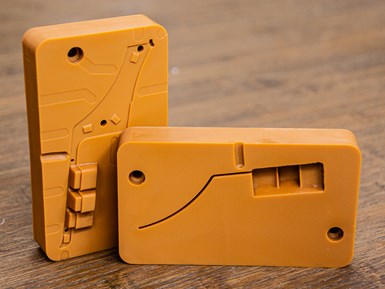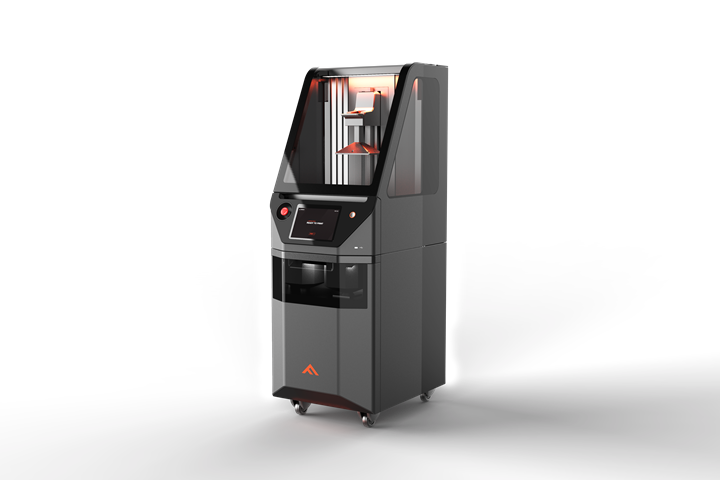Printing Platform Allows Introduction, Orientation of Functional Fillers
A 3D printing startup technology’s ability to evenly disperse functional additives to photopolymers and align reinforcing fibers within the resin during cure is drawing moldmaking interest.
Founded in 2016 on its patented DCM (Digital Composite Manufacturing) platform, Fortify (Boston, Mass.) runs what it calls fiber-reinforced DLP/SLA resins. By reinforcing a photopolymer with microparticle-sized engineering-grade ceramics, Fortify says it has been able to produce injection molding tools that are stronger, stiffer, and exhibit a higher heat deflection temperature, as well as increased wear resistance. The company says present interest is coming mostly in tooling applications but noted it’s gaining traction in printed components.

Reinforcing a photopolymer with fibers that it can align magnetically during printing has given Fortify’s printing technology the ability to create functional tools.
Fortify has recently introduced two additional technologies to its printing platform that make it more suited for the creation of injection molding tool cavities. Its new CKM (Continuous Kinetic Mixing) system ensures additives stay uniformly distributed throughout the material, reducing “sedimentation and aggregation”.
A Fortify spokesperson told Plastics Technology that CKM is integrated into all of its machines, calling it “a key differentiator” that allows it to fully incorporate functional additives into photopolymers. “In future cases, we might see the module not always being used for every material,” the spokesperson said, “but it is a key piece that makes our tooling applications so successful.”
The company is currently providing materials pre-loaded as master batches, and it has printed parts that are up to 20% filled. In terms of fiber length, Fortify said the process uses high aspect ratio fibers that are shorter than the layer height of 50 microns. Longer fibers up to 1 mm can be used, but not oriented in the Z axis. To determine uniform dispersion of the fibers in printed parts, Fortify uses TGA (thermogravimetric analysis), SEM (scanning electron microscope) and optical microscopy. In terms of materials the company has applied, Fortify notes that it’s had success with ceramic and glass fibers, as well as metal flake and “a range of different fillers and morphologies.”
In addition to CKM, Fortify’s printer utilizes what it calls Fluxprint—a magnetic technology that aligns reinforcing fiber within a photopolymer resin during fabrication. To achieve this, fibers undergo a proprietary treatment to make them magnetically responsive. Magnetic fields then align fibers throughout the build to optimize strength, stiffness and other characteristics of the part. The company says users can now optimize fiber orientation based on load conditions of their parts. In terms of how localized the fiber orientations can be, Fortify notes it’s highly localized, down to the 50-75 micron level.

Fortify’s 3D printing platform has found early success in moldmaking applications.
Related Content
-
How to Design Three-Plate Molds – Part 3
There are many things to consider, and paying attention to the details can help avoid machine downtime and higher maintenance costs — and keep the customer happy.
-
The Connector Conundrum: 3D Printed Mold Tooling’s Role in Innovation
ReelView Fishing faced an electronics obstacle in the development of its new technology for underwater video. Additive manufacturing for moldmaking allowed for the speed necessary to iterate to a solution. How inventors and invention will benefit from new ways of obtaining production-ready tooling.
-
Scaling New Heights With Vertical Integration
Eden Manufacturing was founded on a vision of vertical integration, adding advanced injection molding capabilities to a base of precision moldmaking and more recently bringing Swiss-type machining capabilities in-house.















